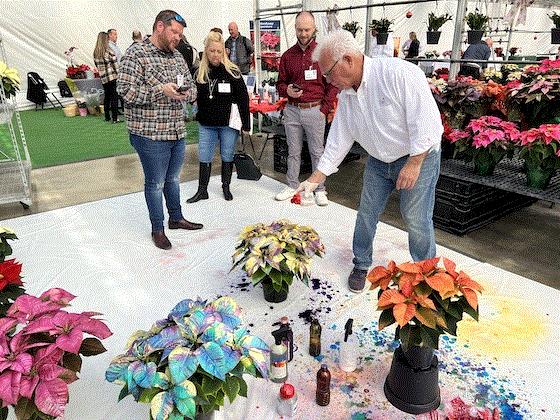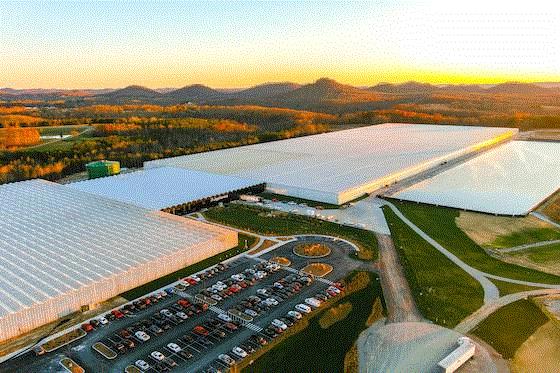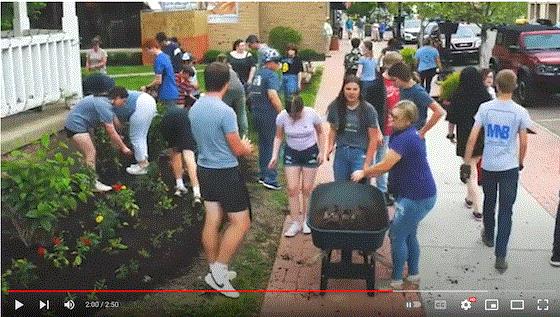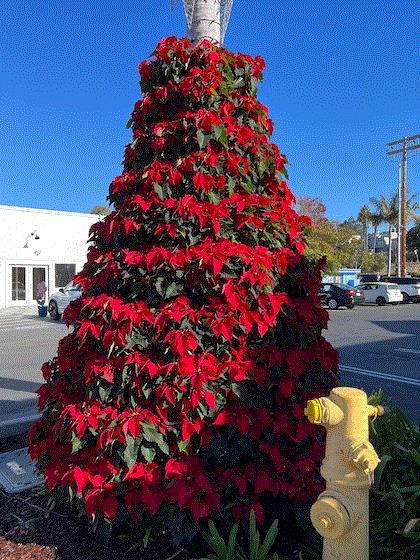It’s painted poinsettia time!
Oh, come on, don't quit reading me just because I happen to like the things.
Red, white, pink and novelty poinsettias are fine, the bread-and-butter of the holiday floriculture season, but you know I like painted poinsettias because they give the grower and retailer the opportunity to create something completely unique. AND I like them because they cause consumers to stop in their tracks to see if they're real or not.
 Ball's Andrew Lee demonstrates Fantasy Colors at Heimos' poinsettia open house a couple weeks ago.
Ball's Andrew Lee demonstrates Fantasy Colors at Heimos' poinsettia open house a couple weeks ago.
So send me photos of your prettiest, gallery-worthy painted, dyed and glittered poinsettias and tell me how they’re selling (and for how much). Also feel free to tell me how much you despise the things, how they’re the scourge of Christmas and a crime against nature (as if a glitter poinsettia shows up in the mountains of Mexico).
Laurie and I will be heading out over the next few weekends to see poinsettias at retail in Chicagoland; until then, here are a few from my favorite local poinsettia painter, Chris Williams, president of K&W Greenery in Janesville, Wisconsin.
Chris reports that during their annual Christmas open house the weekend before Thanksgiving they sold more than 50 painted poinsettias.
“The most popular are blue and the splotchy (carnival) ones,” he says. He paints three sizes—5 in., 6.5 in. and 8 in.—and prices are healthy: $17.99 (vs. $9.99 for plain), $29.99 (vs. $19.99) and $44.99 (vs. ($34.99), respectively.
If you’re painting poinsettias and pleasing customers with them (or at least inspiring heated debates), send some pictures and details to beytes@growertalks.com. If you can't stand them, well, you can tell me that, too! (But it won't stop me from writing about them.)

AppHarvest running out of money
Running out of other people’s money, I might add. That’s according to public filings and reporting by the Lexington Herald-Leader November 22. I can’t say I’m surprised. When I heard the kind of massive sums that investors were sinking into the Kentucky greenhouse vegetable project, I doubted they’d ever be able to pay it back selling beefsteaks and cherries.
In its November 7 SEC filing, AppHarvest reported net sales for the first nine months of 2022 of $10 million, but operating expenses and cost of goods sold totaling $83 million. They also list $458 million in property and equipment. The company has spent at least $641 million on operations and fixed assets since 2018 when it incorporated.
How in the world do you pay your investors back $641 million selling tomatoes and lettuce and strawberries? You don’t. And anyone familiar with the greenhouse vegetable business could have warned them of that fact.
The Herald-Leader reported this:
AppHarvest, the ambitious Morehead-based produce company that planned to open 12 huge, high-tech, indoor farms across Central Appalachia by 2025, told investors this month that it’s running out of cash. It’s also removing two top executives as part of a “restructuring” that will cost up to $7 million in severance payments. Projected net sales for 2022, which the company set at $24 million to $32 million earlier this year, have been revised downward to $14 million to $17 million, or barely half the original sum.
The company blames supply chain-related delays in opening three new farms. Net losses also will be worse than originally forecast, the company says.
“Management believes there is substantial doubt about our ability to continue as a going concern,” AppHarvest warned investors November 7 in its 10-Q filing for the third quarter of 2022.
“Absent additional sources of financing, we expect that our existing cash and cash equivalents will only allow us to continue our planned operations into the first quarter of 2023,” the company said.

It's a beautiful facility in Morehead, Kentucky, and a good chunk of AppHarvest's $458 million in assets.
It’s a shame, really, because the idea was to bring jobs to Appalachia. But getting coal miners to pick tomatoes is one thing—growing them in hot, humid Kentucky is another. And when you promise harvests based on the world’s best operations when you have zero experience and assume zero losses, well, you’re definitely setting yourself up to underdeliver.
Interestingly, AppHarvest has gotten $30 million in last-minute financing from Mastronardi Produce-USA, their exclusive marketing and distribution partner. Hmmm … I wonder if that's who might wind up taking over the operation when the big notes come due?
You can read the 10-Q filing HERE. It’s loaded with interesting detail. And read the Herald-Leader story HERE.
As for the company's stock? It peaked at $35.70 in February 2021. Today it's at 87 cents.
The spin continues
In the meantime, on the very next day, November 23, there was this story:
AppHarvest Initiates Shipment of Tomatoes From its Latest Facility
With the subtitle: Company increases crop set with new premium snacking tomato varieties. In an effort to treble the number of farms in 2022, the company announced the planting of 360,000 tomato plants at a new 60-acre Richmond, Kentucky, farm.
Also in the meantime … Infarm making cuts
The three co-founders of vertical farm company Infarm sent a LETTER to all employees on November 28 announcing a “path forward for Infarm through the challenging business environment that we are currently facing.” That path includes laying off around 500 employees (about half their total workforce) and consolidating their 17 or so “growing centres” to their three core markets, Frankfurt, Copenhagen and Toronto. (They still plan to open one in Baltimore in 2023.) They're downsizing operations in UK, France and the Netherlands.
The reason? Infarm blames outside factors, including energy prices, inflation, supply chain disruptions and rising material costs ... you know, the same factors you face.
Founded in Germany in 2013, Infarm has raised a total of $604.5 million. And late last year, the company was dubbed “Europe’s first vertical farm unicorn” for having a $1 billion valuation.
State of the Industry white paper available
AmericanHort, the leading association for our industry, is offering everyone—member or not—their 2022 State of The Industry White Paper to assist you with your business planning going into the next year. This 17-page paper provides you with an economic review of 2022 with detailed discussions on these topics:
- Inflation
- The likelihood of a recession
- Production and supply chain costs
- The housing market and what it means for our industry
- The political climate and anticipated impact of the mid-term election results—particularly on key issues for the green industry
The report also includes a glimpse of what's happening with companies like Scotts Miracle Gro, Weber Inc. and Sherwin Williams as indicators business owners might watch for while planning for 2023.
Here's a taste of what’s in the report, compliments of section headers called “The Takeaway.”
When is a Recession Really a Recession? We seem to be close.
The Takeaway: Abundant economic headwinds create significant risk for the economy and our industry in the next year. The Fed will work to tame inflation, creating an economic slowdown in the months ahead. But strong consumer spending, low unemployment, improving supply chains and decent housing starts may mitigate big problems for our industry until after next summer. There’s hope that a recession would be relatively short lived and the Fed would signal rate tapering by the end of next year—boosting the economy. Hang on for a bumpy ride.
Production Costs and Supply Chains—Getting better or worse?
The Takeaway: Inflation is at the core of our supply chain cost issues. Energy costs drive heating, fertilizer, transportation and plastic costs, among others. Labor is obviously a key production input across our industry and significantly affects trucking and many other supply-chain services. A slowing economy might help labor on the margins, but our growing dependence on seasonal visa workers will keep labor costs relatively high. A resolution of the war in Ukraine would start to help energy prices come down, but damage to critical energy infrastructure in Europe may delay any relief. Backorders for key inputs like containers and media seem to be catching up as we move into 2023. There are few signs of near-term supply chain cost relief, but we may see significant consumer demand destruction from an economic slowdown. Managing inventory, cash and debt will be paramount moving through next season.

State of the Industry (continued)
Housing Starts and Stops—A proxy for landscape?
The Takeaway: A significant portion of our industry output clears through the landscape channel, mostly to new home construction or landscape remodel. Although top-line economic signals point to a slowdown, demand for single-family housing starts and still “relatively” low interest rates by historical standards (those of you old enough to remember the ’80s), should keep adequate landscape channels open. If the Fed signals a rate taper by end of 2023 or start of 2024 our industry should weather the storm well.
The Political Conundrum—The impacts of the mid-terms and government programs
The Takeaway: “Elections have consequences,” as is often said and this mid-term election will certainly have consequences regarding control of Congress. The economy, global affairs, crime, immigration, health care, social issues, political instability and many more dominate messaging, polling and campaigning. Our industry performance is intertwined with impacts of legislative and regulatory decisions. Sensible labor reform, tax policy, farm policy and environmental rules are all needed to help our industry grow and succeed. It is becoming increasingly difficult to rally adequate support in D.C. to govern well. That makes AmericanHort advocacy efforts all the more important.
Canary in the Coal Mine? Scotts Miracle-Gro, Weber
The Takeaway: In many cases, we compete for consumer discretionary spending with alternative or complimentary consumer products. While Home Depot is still reporting strong sales and earnings, Lowes, Sherwin-Williams, Weber Grills and Scotts Miracle-Gro have experienced significant market headwinds in 2022 that have impacted their financial, operational and market performance. Look for “lessons learned” from perhaps unconventional sources and a possible heads up for our industry.
Business Owners—What to watch for and how to plan
The Takeaway: Our industry has done an excellent job attracting new customers to our products and services over the past two years, helping a new group of consumers enjoy the health, economic and environmental benefits of our industry outputs. It has been enjoyable and profitable to watch families engage with plants, gardening and landscaping. Our industry did an outstanding job protecting employees and customers during the pandemic, and then finding unique and creative ways to navigate supply chain constraints, labor shortages and raising costs. We were given the opportunity and we capitalized on it. Congratulations!
For all the in-depth analysis of the topics above, check out the full white paper HERE.

Jiffy grows its sales team
If you need technical help regarding your Jiffy propagation products, and you're in the Southeast, Midwest or the Ontario, Alberta and Saskatchewan regions of Canada, you'll be seeing a fresh face in your greenhouse.
Freeman Agnew has joined the Jiffy North America sales team as territory account manager for the Southeast area of the U.S.—Louisiana, Mississippi, Alabama, Tennessee, Georgia, Florida, North Carolina and South Carolina. Freeman has a solid background in horticulture and plug production, with previous experience working at a large wholesale grower of vegetables and annuals. He's a 2010 graduate of Auburn University with a degree in Ornamental Horticulture.
Chris Wacker is the territory account manager for North and South Dakota, Minnesota, Wisconsin, Iowa, Nebraska, Kansas and Missouri. He’s an experienced greenhouse and propagation manager, and a 2009 graduate of the University of Wisconsin with a degree in Horticulture.
Josh DeVries is Jiffy’s new territory account manager servicing Ontario, Alberta and Saskatchewan, Canada. Prior to joining Jiffy, Josh was a senior sales account manager for Sheridan Nurseries in Ontario. Josh attended Hillsong College in Sydney, Australia.

Branded pot no longer required for Hollywood Hibiscus
This business is tough enough, so due to the ongoing supply-chain issues growers are facing, J. Berry Nursery is cutting you some slack and dropping their branded container requirements for its Hollywood Hibiscus tropical hibiscus brand. And that’s effective immediately. As in right now!
That means, when purchasing young plants, you don’t need to buy Hollywood Hibiscus branded pots. In fact, while 1- and 2-gal. Hollywood Hibiscus pots will continue to be manufactured by Nursery Supplies, the smaller 1- and 2.5-qt. containers will no longer be stocked.
“Our industry faced incredible supply-chain issues beginning in 2020 and we’re still experiencing unprecedented delays securing materials,” says Jesse Hensen, Global Supply Chain Manager for J. Berry. “While our branded containers command retail customers’ attention and provide excellent merchandising potential of our premier hibiscus genetics, we also understand the challenges faced by our young plant producers and brokers. We want to ease the production process for them by eliminating the need to secure branded containers, so they can focus their time and effort on producing beautiful plants.”
Just because they’re cutting you some slack doesn’t mean they aren’t still encouraging you to us the 1- and 2-gal. branded pots when available, citing the extensive marketing efforts they’ve put behind the Hollywood Hibiscus brand.

Trophy trees as a status symbol?
I was clued into this bit of trivia by Tal Coley, new CEO of the Florida Nursery, Growers & Landscape Association, who published it in his “Tal’s Intel” newsletter to FNGLA members.
According to Amanda Hoover of Morning Brew, “For America’s wealthy, trophy trees are the latest status symbol.” Amanda interviewed Justin Fox of Foxterra Design, a California-based exterior design firm owned by Justin and his brother, Nate.

“It’s not the tile in the driveway, it’s not the custom walls, it’s not the water feature—it’s the statement tree because it allows you to have this livable, mature feeling of tranquility that nothing else would give,” Justin told Morning Brew. Here’s a bit from that piece:
One Foxterra client in Massachusetts bought palm trees and plans to replace them each year, as they’ll die in the cold New England winters, the brothers said. In Oregon, Conifer Kingdom grows trophy trees and sells them to people across the nation. Customers come from as far as Chicago and Long Island to pick out towering trees that can cost as much as $75,000. They traverse the country in refrigerated freight trucks, sometimes in pots weighing as much as 5,000 pounds to keep their roots watered and alive.
“It’s a little bit of a status symbol thing,” said Sam Pratt, sales and inventory manager of Conifer Kingdom. “But it’s also that people like plants, and particularly for our more wealthy customers, they tend to be a little more aged and so they don’t want to wait for them to grow large. They want to start with them large.”
You can read the entirety HERE.
To get a feel for what the brothers design, check out their TikTok channel, which has 1 million followers. In fact, if you wonder what a successful landscape design TikTok video looks like, HERE is a good example.

Do you know "The Garden Song"?
I didn’t—not until I watched this heartfelt, locally produced VIDEO from the small town of Logan, Ohio (population 7,349), promoting their participation in America in Bloom and how it helped revitalize the community. "The Garden Song" is sung by the Logan High School A Capella Group.

I was trying to catch the lyrics, but couldn’t quite, so I Googled the song. It begins:
Inch by inch, row by row
Gonna make this garden grow
All it takes is a rake and a hoe
And a piece of fertile ground
Inch by inch, row by row
Someone bless these seeds I sow
Someone warm them from below
Till the rain comes tumblin’ down
"The Garden Song" was written by folksinger David Mallet in 1975, but it was most famously performed by John Denver—including on "The Muppet Show," complete with singing Muppet flowers.
Finally …
Despite the Ecke Ranch being long gone from the poinsettia business in Encinitas, the little California town has not forgotten its history. Resident poinsettia breeder Steve Rinehart sent me this picture of a poinsettia “tree.” I assumed it was at some important central location … and it is: Hansen’s Surfboard Shop on historic Highway 101 (I actually owned a Hansen surfboard back in the mid-'70s).


It’s “drawing attention!” Steve wrote, adding, “ I would say it’s the highlight of the Encinitas decorations!”
If Steve introduces a variety called Surf’s Up or Hang Ten, I'll know where he got his inspiration.
Feel free to email me at beytes@growertalks.com if you have ideas, comments or questions.
See you next time!

Chris Beytes
Editor
GrowerTalks and Green Profit
This e-mail received by 26,194 loyal readers!
Thanks to my loyal sponsors, who help me reach the 26,194 readers of Acres Online in more than 60 countries. Want to be one of them (a sponsor, that is)? Give Kim Brown a shout and she will tell you about our many advertising opportunities.